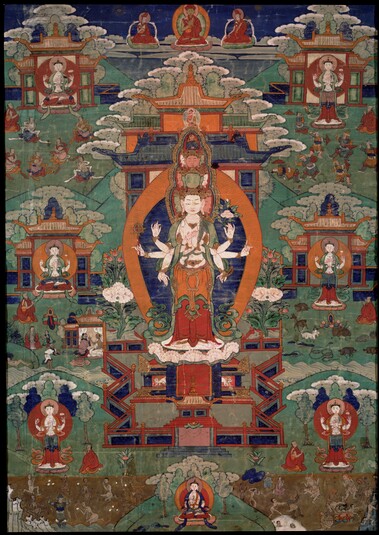
Item: Avalokiteshvara (Bodhisattva & Buddhist Deity) - (11 faces, 8 hands)
| Origin Location | Tibet |
|---|---|
| Date Range | 1800 - 1899 |
| Lineages | Drukpa (Kagyu) |
| Material | Ground Mineral Pigment on Cotton |
| Collection | Private |
Alternate Names: Lokeshvara Avalokita Lokanata Lokanatha Mahakarunika
Classification: Deity
Appearance: Peaceful
Gender: Male
Avalokiteshvara, Ekadashamukha (Tibetan: chen re zi, shal chu chig. English: the Eleven Faced Lord Gazing on the World): with emanations appearing in each of the six realms of existence.
Peaceful in appearance, white in colour, he has eleven faces and eight hands. The main face is white, right green and left red. The upper faces are in two rows of red, green and white and then white, red and green. Above that is a dark wrathful face topped with the red peaceful head of Amitabha. The two main hands are clasped at the heart. The upper right hand holds a crystal mala, second a golden Dharma wheel and the lower hand performs the mudra of generosity. The upper left hand holds a pink lotus flower, second a vase and the lower a bow and arrow. Each face is adorned with a crown and earrings. The body is further decorated with necklaces, bracelets and silks of various colours. Above a moon disc, pink lotus blossom and lion supported throne he stands wreathed in a nimbus of blue and orange light in a courtyard before an ornate temple structure. On the upper floor of the temple is the buddha Amitabha, red in colour, with one face and two hands in the mudra of meditation.
At the top center a figure wearing monastic robes and a red cap performs the mudra of Dharma teaching, seated on a pink lotus. At each side two monks seated on cushions perform various mudras.
At the upper left side is Sadaksari Avalokiteshvara with one face, four hands and seated, appearing before a gathering of peaceful contented gods. At the right side in a standing manner he appears to quell the passions of a group of battling asuras (demi-gods). At the middle left in a seated posture he dwells in the human realm of joy and misery. At the right he stands before an assortment of various living creatures - the animal realm. At the lower left he appears in the world of the hungry ghosts. At the right he stands before the suffering beings of the hell realms. At the bottom center is the peaceful deity of purification Vajrasattva, white, with one face and two hands holding a vajra to the heart and a bell at the waist.
The bodhisattva Avalokiteshvara is the patron deity of Tibet and appears in a variety of forms both peaceful, wrathful and in large mandalas surrounded by numerous deities. As a universal symbol he represents the compassion of all buddhas of the ten directions and three times. Lord Atisha, Rinchen Zangpo and others popularized this form of the deity throughout Tibet.
Jeff Watt 3-99
Tradition: Kagyu Deity Paintings
Collection: Private 1
Buddhist Deity: Avalokiteshvara (Eleven Faces)
Tradition: Drugpa Kagyu Main Page
Subject: Hell (Main Page)
Buddhist Deity: Avalokiteshvara (Eight Hands)
Buddhist Deity: Avalokiteshvara (Drigung Kagyu Tradition)
